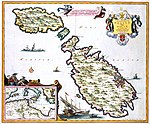
Back Malte byzantine French ბიზანტიური მალტა Georgian Византиска Малта Macedonian Bizantyńska Malta Polish Malta bizantina Portuguese Bizantinska Malta Slovenian Візантійська Мальта Ukrainian
| History of Malta |
|---|
 |
|
|
Malta (Greek: Μελέτης, Melétēs) was ruled by the Byzantine Empire, from the time of the Byzantine conquest of Sicily in 535-6 to 869-870, when the islands were occupied by Arabs. Evidence for the three centuries of Byzantine rule in Malta is very limited, and at times ambiguous. Historians theorise that Byzantine Malta was exposed to the same phenomena affecting the Central Mediterranean, namely a considerable influx of Greek settlers and Hellenic culture, administrative changes brought about by the reorganisation of Sicily along the lines of a Byzantine theme, and significant naval activity in the Mediterranean following the rise of Islam.
Byzantine sources are scant on the Maltese islands, although a handful of records group them together as the Gaudomelete (Γαυδομελέτη, Gaudomelétē),[1] a term that first appears in the pseudoepigraphical Acts of Peter and Paul.[2]: 76 The islands were a place of relegation and exile. With Muslim expansion in North Africa, Malta shifted from a military base and trade post linking Sicily and the other Byzantine possessions in the Italian peninsula to the Exarchate of Africa, to an outlying satellite and guardpost of the Byzantine Theme of Sicily.[1]
Historians have concluded that Malta played a limited strategic role in the Byzantine Empire.[3] The subsequent Arab conquest led to a complete break between the Byzantine era and later periods. While there are studies about alleged Byzantine or Christian survival, the sparseness of evidence implies a weak case for a lasting Byzantine legacy in Malta.[3]
- ^ a b Dalli 2008, p. 247.
- ^ Fiorini, Stanley; Vella, Horatio C.N. "Reactions to Tristia ex Melitogaudo: A Response" (PDF). Literatūra. 58 (3): 75–87. doi:10.15388/Litera.2016.3.10425. Archived (PDF) from the original on 2020-07-09. Retrieved 2020-04-25.
- ^ a b Brown 1975, p. 86.
© MMXXIII Rich X Search. We shall prevail. All rights reserved. Rich X Search